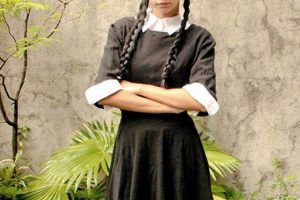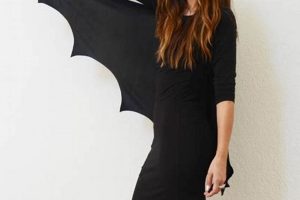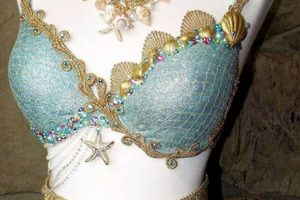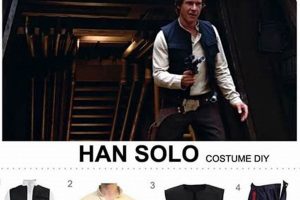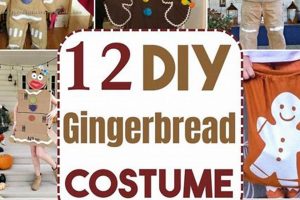A homemade version of the attire worn by the character Vanellope von Schweetz allows individuals to replicate the unique clothing style through self-made or modified garments. The objective is to create an outfit that visually embodies the character’s recognizable aesthetic using available materials and crafting techniques. An example would be assembling a teal hoodie, brown skirt, striped leggings, and black boots, then adding details such as candy embellishments to mirror the characters design.
Constructing the character-inspired outfit yourself offers several advantages. It presents a cost-effective alternative to commercially produced costumes, permitting creative control over the final appearance. The creation process also offers a sense of personal satisfaction and potentially enhances crafting abilities. Historically, replicating character costumes has been a popular activity amongst fandoms, evolving from simple imitations to elaborate, personalized recreations.
The subsequent sections will detail practical approaches to constructing individual components of the character’s apparel, sourcing appropriate materials, and employing techniques for recreating signature design elements, enabling the realization of a recognizable character representation.
Constructing a Vanellope von Schweetz-Inspired Outfit
The following recommendations offer guidance in creating a credible replica of Vanellope von Schweetz’s distinctive attire. Each suggestion focuses on specific aspects of the costume and provides actionable steps for successful replication.
Tip 1: Source Authentic Hoodie Materials: Begin with a teal-colored hooded sweatshirt. The material should ideally be a cotton-poly blend for comfort and durability. Consider sourcing a pre-made hoodie in the correct shade or purchasing fabric to sew a custom garment.
Tip 2: Replicate Skirt Texture: The brown skirt should be a corduroy or similar textured material. A-line or slightly flared styles closely resemble the character’s skirt. A pre-existing skirt can be altered, or a new one can be sewn from purchased fabric.
Tip 3: Accurately Reproduce Leggings: The striped leggings are a critical element. Search for pre-made striped leggings, or use fabric paint or markers to create stripes on plain leggings. The stripe pattern should be closely matched to reference images.
Tip 4: Embellish with Candy Details: Attach candy-themed embellishments to the hoodie and hair. Faux candy pieces or securely attached, real, wrapped candies can be used. Ensure these additions are securely fastened to prevent detachment.
Tip 5: Footwear Considerations: Black boots or sneakers are suitable footwear choices. Boots can be modified with paint or fabric to add details, if desired. Ensure the footwear is comfortable for extended wear.
Tip 6: Hairstyle Accuracy: The character’s pulled-back hairstyle can be replicated with hair ties or bobby pins. Experiment with different arrangements to achieve the desired volume and shape.
Tip 7: Prioritize Comfort and Fit: Throughout the construction process, prioritize the comfort and fit of each garment component. Ill-fitting or uncomfortable clothing will detract from the overall appearance and wearability.
Adhering to these recommendations will contribute to a more accurate and visually appealing result. Attention to detail and careful material selection are crucial for a successful recreation of the character’s recognizable aesthetic.
The following section will address potential challenges and troubleshooting strategies encountered during the fabrication process.
1. Teal hoodie sourcing
The acquisition of a teal hoodie represents a foundational element in the successful execution of a character-inspired ensemble. Its color and style dictate the initial visual impact and significantly influence the overall authenticity of the homemade recreation.
- Color Accuracy
Achieving color accuracy is paramount. The specific shade of teal directly correlates to the character’s depicted appearance. Deviations from this shade can diminish the recognizability of the costume. Retail availability of specific teal shades may necessitate dyeing a plain white hoodie to achieve the precise hue.
- Fabric Selection
The fabric composition influences both the garment’s appearance and wearability. A cotton-polyester blend offers a balance of comfort and durability, while fleece-lined options provide added warmth. The chosen fabric should drape similarly to the character’s animated depiction to maintain visual consistency.
- Style Considerations
The hoodie style encompasses details such as the presence or absence of a front zipper, the shape of the hood, and the style of the cuffs and waistband. A pullover hoodie with a standard hood shape most closely aligns with the character’s design. Minor style alterations, such as removing drawstrings, may further enhance accuracy.
- Sizing and Fit
Appropriate sizing is crucial for both visual accuracy and wearer comfort. An ill-fitting hoodie, either too large or too small, can detract from the overall appearance. Referencing size charts and potentially purchasing a size up to allow for layering is advisable.
The facets of color accuracy, fabric selection, style considerations, and sizing collectively determine the success of teal hoodie sourcing. Careful attention to each aspect ensures the resulting garment contributes positively to the overall quality and fidelity of the complete character-inspired attire.
2. Corduroy skirt replication
The accurate replication of the corduroy skirt constitutes a significant challenge within the scope of constructing a homemade Vanellope von Schweetz costume. The skirt’s texture, color, and style contribute substantially to the overall recognizability of the character’s distinctive appearance. Therefore, successful reproduction of this garment element demands meticulous attention to detail.
- Material Selection and Texture
The defining characteristic of the skirt is its corduroy texture. Opting for a different fabric, such as denim or twill, significantly diminishes the costume’s authenticity. The width of the corduroy wales (the raised ribs) is also a factor; a medium-width wale generally provides the most accurate visual match. Sourcing genuine corduroy fabric is therefore essential.
- Color Accuracy and Dyeing
The skirt’s shade of brown requires careful consideration. Reference images of the character should be closely examined to identify the correct hue. If commercially available fabrics do not match the desired color, dyeing a lighter-colored corduroy may be necessary. This process demands caution to ensu
re even color distribution and prevent damage to the fabric. - Style and Construction
The skirt’s style typically involves an A-line or slightly flared silhouette. Patterns for similar skirt styles are readily available commercially or online. Precise measurements and accurate sewing techniques are crucial for achieving the correct fit and shape. The hem length should also be considered to match the character’s on-screen depiction.
- Distress and Wear Simulation
Certain interpretations of the character’s costume incorporate subtle distressing or signs of wear on the skirt. These details, while not always present, can enhance the costume’s realism. Techniques such as light sanding or the strategic application of diluted fabric paint can simulate this effect.
The successful corduroy skirt replication integrates material selection, color accuracy, style and construction, and distress simulation. When all elements are accurately implemented, the overall effect is a more polished recreation of the costume.
3. Striped leggings accuracy
The precise replication of striped leggings serves as a critical component in the successful creation of a homemade Vanellope von Schweetz costume. The visual distinctiveness of these leggings necessitates meticulous attention to detail, as inaccuracies can significantly detract from the overall authenticity of the ensemble.
- Color Palette Conformity
The color combinations employed within the striped leggings demand rigorous adherence to the source material. Variations in hue or tonal values disrupt the visual harmony of the costume and diminish the character’s recognizability. Exact color matching, potentially requiring custom dye solutions or fabric painting, is crucial for achieving authenticity.
- Stripe Width and Proportionality
The relative widths of the individual stripes and their proportional relationships within the overall pattern are defining characteristics. Deviations from these established dimensions compromise the visual fidelity of the garment. Precise measurements and careful application techniques are necessary to ensure accurate replication of stripe width and spacing.
- Material Consistency and Stretch
The fabric used for the leggings should possess sufficient elasticity to conform closely to the wearer’s legs without distorting the stripe pattern. Inconsistent material properties can lead to uneven stretching, resulting in distorted stripes and a visually unappealing effect. Selecting a fabric with appropriate stretch and recovery characteristics is therefore paramount.
- Seam Alignment and Pattern Continuity
Seamless construction or meticulous seam alignment is essential for maintaining pattern continuity across the leggings. Misaligned seams disrupt the flow of the stripes, creating a visually jarring effect that detracts from the overall appearance. Precise cutting and sewing techniques are required to ensure seamless pattern integration.
The interplay of color palette conformity, stripe width and proportionality, material consistency and stretch, and seam alignment contributes significantly to the perceived accuracy of the striped leggings. These considerations are fundamental for successfully capturing the visual essence of the character’s attire in a homemade context, demonstrating the importance of detail in crafting a convincing replica.
4. Candy embellishment adherence
Within the context of a “diy vanellope costume,” the term “candy embellishment adherence” signifies the successful and secure attachment of candy-themed decorations to the costume’s components, typically the hoodie and hair accessories. The degree to which these embellishments remain affixed to the costume directly affects its visual integrity and overall recognizability as a replica of the character’s attire. Inadequate adhesion leads to lost or misplaced candy pieces, diminishing the costume’s accuracy and potentially impacting the wearer’s experience. For example, if candy pieces detach during wear, the costume loses its intended aesthetic, and the wearer might experience discomfort or self-consciousness.
Effective “candy embellishment adherence” necessitates careful consideration of adhesive types and application methods. Factors such as the weight and size of the candy pieces, the texture of the fabric, and the intended duration of wear influence the choice of adhesive. Hot glue, fabric glue, and specialized craft adhesives represent viable options, each possessing unique strengths and weaknesses. A poorly chosen adhesive, or improper application, can result in both immediate detachment and long-term degradation of the bond. Consider, for example, a situation where hot glue is applied too thinly; the candies may detach after only a short period of wear. Conversely, using an excessive amount of adhesive can create a stiff, unnatural appearance, detracting from the overall aesthetic.
In conclusion, “candy embellishment adherence” represents a pivotal element in achieving a convincing “diy vanellope costume.” Secure and aesthetically pleasing attachment of candy decorations ensures the costume retains its intended appearance and enhances the wearer’s experience. Careful consideration of adhesive selection, application techniques, and the physical properties of the embellishments is crucial for long-lasting and visually effective results, directly impacting the success of replicating the iconic character’s design.
5. Footwear style conformity
Within the context of creating a “diy vanellope costume,” “footwear style conformity” denotes the degree to which the selected footwear accurately replicates the character’s depicted shoes. Footwear directly impacts the overall visual impression of the costume. The selection of incongruous footwear diminishes the costume’s authenticity, irrespective of the accuracy of other components. For instance, substituting high-heeled shoes for the character’s sneakers significantly alters the costume’s intended aesthetic, detracting from its recognizability.
Achieving “footwear style conformity” involves considering various factors, including color, style, and detailing. The character is typically depicted wearing black, lace-up boots or sneakers. Replicating this detail necessitates sourcing footwear that closely matches these characteristics. Modifications to existing footwear, such as painting or adding embellishments, can enhance accuracy. Practical applications include searching online retailers for boots or sneakers that resemble the character’s shoes or repurposing existing footwear through careful alterations to match the style. For example, plain black sneakers can be modified by adding stripes or other decorative elements.
In summary, “footwear style conformity” constitutes an essential element in the creation of a convincing “diy vanellope costume.” While the hoodie, skirt, and leggings contribute significantly to the character’s recognizability, the choice of footwear serves as a crucial finishing touch. Accurate replicati
on of the character’s footwear style enhances the costume’s overall impact, lending credibility to the homemade representation.
6. Hairstyle visual congruence
Hairstyle visual congruence, in the context of a “diy vanellope costume,” refers to the degree to which the styled hair accurately reflects the character’s distinct hairstyle as depicted in source materials. This element significantly impacts the overall effectiveness of the costume; a hairstyle that deviates considerably from the established visual representation diminishes the costume’s authenticity and may hinder immediate character recognition. The causal relationship is direct: a high degree of congruence results in a more believable representation, while low congruence detracts from the illusion. An example illustrates this point: a costume featuring accurate clothing elements paired with a completely dissimilar hairstyle, such as long, flowing locks instead of the character’s signature pulled-back style, fails to fully capture the character’s persona.
Achieving hairstyle visual congruence necessitates careful observation of reference images and the employment of appropriate styling techniques. This might involve manipulating the wearer’s natural hair to mimic the character’s style through methods such as pulling it back into a ponytail or bun, securing it with clips or hair ties, and potentially adding volume or texture to match the depicted appearance. Color is also a vital consideration. If the wearer’s natural hair color differs significantly from the character’s, temporary hair dyes or colored hairsprays could be used to enhance congruence. Furthermore, accessories, such as candy-themed hair clips, often contribute to the character’s overall look and should be incorporated to maximize accuracy. An illustration of this would be the addition of strategically placed faux candy pieces to the hair, mimicking the character’s whimsical style.
In conclusion, hairstyle visual congruence plays an essential role in the successful execution of a “diy vanellope costume.” While clothing and accessories contribute to the overall impression, the hairstyle functions as a defining element. A faithful recreation of the character’s hairstyle, achieved through careful styling, appropriate color choices, and the incorporation of relevant accessories, enhances the costume’s authenticity and contributes significantly to its overall effectiveness. Challenges might arise from differing hair types or lengths, but strategic styling techniques and the use of accessories can overcome these obstacles, ensuring the hairstyle complements the costume and solidifies the character representation.
Frequently Asked Questions
The following section addresses common inquiries regarding the creation of a costume inspired by Vanellope von Schweetz. The information presented aims to provide clarity and guidance for individuals undertaking this project.
Question 1: What is the most critical element for a recognizable Vanellope costume?
The teal hoodie is arguably the most recognizable and therefore critical element. Its specific shade and style are immediately associated with the character. Deviations from the correct color or hoodie style significantly impact the costume’s overall recognizability.
Question 2: Are commercially available teal hoodies sufficient, or is dyeing necessary?
The availability of teal hoodies in the precise shade required may be limited. In cases where a commercially available option does not match the desired hue, dyeing a plain white hoodie represents a viable alternative. This approach allows for precise control over the final color.
Question 3: What type of adhesive is recommended for attaching candy embellishments?
The selection of adhesive depends on the weight and size of the candy embellishments and the texture of the fabric. Hot glue and specialized fabric glues are generally suitable options. Ensure the adhesive is compatible with both the candy material and the fabric to prevent damage or detachment.
Question 4: How can striped leggings be accurately replicated if pre-made options are unavailable?
If pre-made striped leggings cannot be sourced, plain leggings can be modified using fabric paint or markers. Precise measurements and careful application techniques are essential for creating accurate and evenly spaced stripes. Consider using stencils to maintain consistency.
Question 5: What considerations are important when selecting footwear for the costume?
Footwear should ideally consist of black boots or sneakers. The style and detailing should align with the character’s depicted shoes. Modifications, such as painting or adding decorative elements, can enhance accuracy. Comfort and practicality are also important factors, particularly for extended wear.
Question 6: How can the character’s hairstyle be effectively replicated, particularly with varying hair lengths?
Replicating the hairstyle involves pulling the hair back into a ponytail or bun and securing it with clips or hair ties. For shorter hair, consider using hair extensions or wigs to achieve the desired volume and shape. Accessories, such as candy-themed hair clips, further enhance the overall effect.
Achieving a convincing Vanellope von Schweetz costume involves careful attention to detail and a thorough understanding of the character’s distinct visual elements. By addressing these frequently asked questions, the costume creation process becomes more accessible and yields a more accurate final product.
The subsequent section will address potential challenges and troubleshooting strategies encountered during the fabrication process.
DIY Vanellope Costume
This exploration of the “diy vanellope costume” has detailed the critical elements required for a recognizable and accurate recreation of the character’s attire. Considerations ranging from the precise shade of the teal hoodie to the accurate replication of striped leggings and the secure adherence of candy embellishments have been addressed. The importance of footwear style conformity and hairstyle visual congruence has also been emphasized. Successfully navigating these challenges contributes to a final product that effectively captures the essence of the character’s visual identity.
The construction of a “diy vanellope costume,” while demanding attention to detail, offers a rewarding endeavor for those seeking a unique and personalized representation. The information presented serves as a foundation for individuals undertaking this project. Ultimately, a commitment to accuracy and creative problem-solving yields the most compelling and satisfying results.


